I have several athearn streamliner and heavyweight passenger kits and i was just curious how accurate are they? are they based on prototype cars or the whimsy of model railroad car designers. the heavyweight round roof cars remind me of some similar looking coaches i saw in late 1960’s on the C&O near bellaire or brutus michigan.
Athearn cars fill a niche market. That being said, they are not full length. They are intended for people who have really sharp curves (usually less than 22"). They are fair in detail. I don’t personally own any but know of several people that have them. They are not based on any particular prototype. They do roll smoothly and you can add an interior.
I have 7-8 Athearn streamlined passenger pennsy cars and I absolutely love them. They have weight (unlike IHC), they don’t wobble, they look great. The only tips I have are to replace their couplers with Kadee couplers, this is an easy task and it makes all the difference. Also, on some of the eastern roads like the PRR and N&W, the car sets come with dome cars, which I have heard is not prototypical, so I don’t use the dome car, instead I replace it with another regular passenger to make the train longer.
The passenger cars are a little on short side compared to the prototype, but this doesn’t bother me, they run on virtually any curves, no overhang, very reliable, sturdy cars. Some of them come with light bulbs inside, some of the bulbs work, some don’t out of the box. When the cars do light up, they look amazing and you can’t beat athearn when it comes to prices. Very affordable and reliable.
In this ever changing hobby, sometimes vintage is indeed better. If you hook up 6 old athearn santa fe streamlined passenger cars to a super chief, you won’t be disappointed.
The sreamline mail and baggage cars are based on ATSF cars and are the correct lenth. I think I’ve heard the coach is correct for some eastern road, but I’m not sure. Every other stremline car is too short.
As far as the heavy weights go, the mail and baggage cars are based on a prototype that slips my mind, (probably ASTF), but the rest of them are too short to match any protoype cars AFAIK.
Hi!
Some of the Athearn cars are based on Santa Fe prototypes.
I built up two trains lettered for the ATSF, one heavyweight and one streamline. The heavyweights got KDs, American Limited diaghrams, and Intermountain wheelsets. I sprayed and relettered a few to be more ATSF specific, and ended up with a 13 car “train”.
The streamline cars were similarly upgraded, and I ended up with a 12 car train.
Funny thing… I have a lot of Walthers ATSF light/heavy passenger cars which are more prototypical (spell?). However, having a BLI 4-8-4 pull that string of Athearn heavyweights is one of my favorite sights. I suspect its because “I built them”, but in any case, they get used a lot.
ENJOY,
Mobilman44
First lets seperate the two:
Streamliners - these are totally freelanced and selectively compressed for sharper curves. Virtually all streamlined cars where/are 85’ long. Everyone has their own views about this aspect of the hobby but I use shorter passenger cars like Athearn even though I have 36" radius curves. Remember, a 36" radius curve in HO is a VERY sharp, restricted speed curve on the prototype.
Heavyweights - these cars are also freelanced and do not directly represent any specific prototype - BUT they are closer to many prototypes than the streamliners for several reasons. One, Pullman and other heavyweight builders used standard parts like underframes, ends, vestibule doors, and side panels to make up most cars. Two, not ALL heavyweights where 85’ long, in fact, take away Pullman sleepers and Pullman built diners, lounges and observations and you find more than half the coaches, baggage cars, combines, RPO’s, where less than 80’, with many beng in the 70’ to 75’ range. The Athearn cars are 72’.
Those arch roof cars are very close to a number of prototype 70-75’ arched roof cars that did exist. So are the clerestory roof coach, baggage and RPO.
And, there where several 70’ business cars very similar to the Athearn observation. So only the Pullman and Diner are totally without a close prototype.
The Athearn cars run well and are easily detailed into very nice models if you are happy with their freelanced nature. I prefer them until and unless I can buld a layout with all 60" radius curves.
Sheldon
As some other have mentioned, ATSF did have some short streamlined RPO’s and baggage cars which do appear to be very well represented by the Athearn cars. There has never been any word from Athearn that they where the basis for the streamlined cars.
The details of the heavyweights are typical Pullman car company construction and similar to most all heavyweight cars.
Sheldon
Additionally, I too detail my Athearn cars with working diaphragms from American Limited, close couple them with body mounted Kadee couplers on Jaybee mounting pads, install Intermountain wheelsets, Kadee brake shoes, vestibule interior doors and/or tail gates, mail hooks on RPO’s, ad underbody details from Cal Scale, lighting to some, custom paint them for my freelanced ATLANTIC CENTRAL or the roads we interchange with and they look and run great.
I have also kit bashed the following body types: Combines, full RPO’s, mid train lounges, dome obervations, parlor cars and solarium observations.
Sheldon
The Athearn heavyweights are pretty good representation of Santa Fe cars - not surprising for a company located in California.[:)]
In the heavyweight days, unlike later streamliners, RPO and Baggage cars were usually 70’ or less, Coaches and Combines were normally right around 70’ long, though some 80’ certainly were made. IIRC the Athearn RPO is 63’, the Baggage car is 67’, and the Coach is 70’ or 72’ - all quite correct for heavyweight cars. The Diner, Sleeper and Observation cars are 80’ cars shortened to the same length as the Coach.
BTW the Walthers/Rivarossi/Whoever 60’ cars are all full-size models of real CNW cars. Many railroads used 60’ Baggage cars and 60’ RPO’s were common too. The Coach and Combine are based on CNW’s “Utility Coach” and “Utility Combine” which were used to fill in where necessary, and I guess were often used as smokers.
They’re good running dependable cars, and in recent years have excellent paint and lettering. Palace Car Co. makes interiors for many of the Athearn cars.
I believe all companies that make decoder-equipped engines use decoders that allow DC use also - at least I can’t think of any that don’t allow DC use, but just DCC.
Interesting, I was replying to a different post…not sure how it ended up here?? [D)]
I have a number of Athearn heavyweights that I bought in the days when they and the Rivarossi cars were the best heavyweights you could buy in plastic.
A baggage car has had the sides and roof re-sectioned, letterboards replaced, and door windows re-done to be a close model of a certain series of NH cars. This car was cut into many pieces and re-assembled like a jigsaw puzzle. An interesting exercise.
A business car was made from the observation, with inspection lights, plenty of hoses on the platform end, and prominent kitchen vents added. This car always looked like it was inspired by an AC&F prototype.
Two clerestory coaches were combined to make a longer parlor or chair car which is close to a C&O deluxe coach. For unknown reasons it is lettered for CRR of NJ, car name “Raritan”. A shorter combine was created from the leftover body parts, and a New England Models (?) baggage door.
I also bought a streamline observation, and lengthened it with a section of streamlined diner, to simulate a specific PRR observation (again, with modified letterboards made from.010" styrene). The actual PRR car was #1126, type POC85, Budd-built in 1940. Mine is named “Cdr. Ren Hoek”
The Athearn Pullman is very odd indeed, as the window layout on the sides are identical, leaving no provision for compartments or rooms on one side, and the corridor on the other. There were never any short Pullman sleepers. It is an approximation.
The Athearn round-roof coaches resemble Reading cars, but are off in a number of minor ways.
The six wheel Pullman trucks on the cars were all scrapped, as the wheelbase is less than scale length. I used one pair under a Lehigh Valley well-hole flat car built from a Wabash Valley kit.
I believe you intended to say
Well maybe I should have said not ALL where 80’ long. Most of the Pullman sleepers/diners had measurements over the buffers between 82’ and 84’. I was generalizing a little but there is a missconception among some modelers that all post 1900 steel passenger cars are 80’-85’ long and that all models shorter than that are “selectively compressed”.
Point still remains - many heavyweight cars where shorter than the 80’ plus length of a Pullman sleeper. And there was actually no “standard” length in heavyweight days. Even the Pullman cars that where in the 80’ range varied in length from plan to plan by a foot or two.
Only in the days of ACF and Budd streamliners did car length start to be more standardized.
Sheldon
IIRC the Athearn RPO is 63’, the Baggage car is 67’, and the Coach is 70’ or 72’ - all quite correct for heavyweight cars. The Diner, Sleeper and Observation cars are 80’ cars shortened to the same length as the Coach.
Close, but actually, regarding Athearn heavyweights, the RPO is 67’ and uses a unique floor. All the rest are 72’. The Baggage and Diner share a floor with no steps, the two Coaches and Pullman share a floor with steps at both ends and the Observation has a unique floor for the open platform. The Coach floor and the Baggage floor will interchange with the obvious mismatch regarding the lack or presence of steps. Having done many kit bashes these facts have long been ingraned in my data banks.
Sheldon
The heavy weight clearstory roof cars are quite convincing to my eye. I rode plenty of locals, commuters, and intercity passenger trains with clearstory heavyweight cars that looked a heck of lot like the Athearn models. Some selective compression was done to improve performance on 18 inch curves. But it isn’t much and the result is very realistic. The round roof and streamline cars are perfectly respectable models but the clearstory heavyweights are my favorites.
While the majority of the Athearn cars aren’t based on specific prototypes, with the exception of the heavyweight Pullman, they capture the flavor of a number of cars. They are also shorter then most prototype cars, a concession to the sharp curves common to many model railroads.
Having said that my entire passenger fleet is Athearn cars, both streamlined and heavyweight. The cars remain a bargain compared with the Walthers, and Rapido cars. Through careful bidding on E-bay, I acquired enough equipment to outfit three 4 car trains for around $100. So for the cost of two to three Walthers or Rapido cars, I got 12 Athearn cars.
Nick
Athearn Passenger cars were the best option in many years past, but that being said, they are dated and pale in comparison to what is available today. I can spot an Athearn passenger car a mile away.
That being said, yes you can spend time and money making them look less “Athearny” (new word?), but money is better spent with Rapido, Walthers, Train Station Products, Intermoutain, BLI or Branchline cars because less time is involved. They are beautiful in terms of detail (better than brass) and are available for a reasonable price. Of course you need curves to match and I dont buy into the “85 footers on 36 inch radius curves looks stupid, so I would rather run Athearns because they look better on those curves than prototype length cars” defeatist philosophy that is the opinion of a few people here.
In addition, I have also abandoned;
X2f couplers,
sectional track,
incandescent bulbs
22" radius curves,
CD100 rail
plastic wheels,
IR,
oversized flanges,
layout animation,
NFL themed cars,
Athearn over-wide locos
block control,
commercial turnouts,
underweight cars,
uncoupling magnets,
DC,
truck-mounted couplers,
Pepsi Clear
MRC decoders,
Tyco/Playart/Bachmann/ConCor-everything
and last but not least, brass track…
But hey, these are choices that make the hobby more enjoyable to me…and YES my 85 footers look and run just fine on my 36" radius, thanks.
David B
Hate spending 15 minutes typing a post, hitting the post button, and getting a message that Yahoo encountered an error and had to close the page![soapbox]
I was mentioning how I have been building (and bashing) the Athearn Streamliners since my grade school days, when they first came out under the Globe name, had cast metal dummy knuckle couplers, and the bodies had 2 sides, 2 ends, a floor, and a roof as the major parts. Maybe they aren’t 100% prototypical, are shorter than most similar full scale streamliners (and heavy weights), but look good on the 18" curves. In fact, they operated trouble-free on 15" curves on one of my early 4’ X 6’ Layouts.
They are quite easy to use for kit bashing. In fact, I have an Athearn Combine, a two-unit Articulated Chair Car, a three-unit Articulated Diner, a four Roomette with Lounge car, and a Dome-Observation. Also, I have a couple floor sections that can be set up with chair details and maybe some siding, replicating some open-air railfan cars I’ve seen photos of. Maybe with the addition of some wire 'U’s and Northeastern hollow caboose roof.
Main trouble is, if I set up all my Athearn Streamliners on my main behind my Alco PA-1 or F-M C-Liner Passsenger units, both A-A lash-ups, a passenger in the Dome-Observation could just about stick a hand out the tail end and touch the nose of the lead loco.
A few Athearn ex-Pullmans:
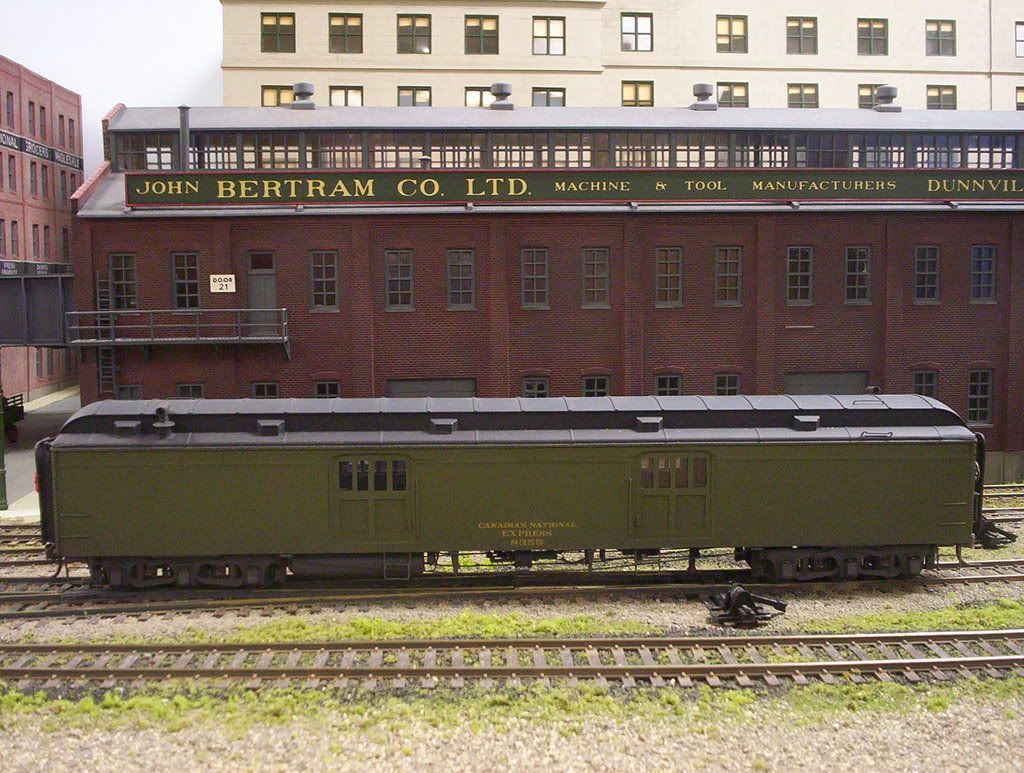
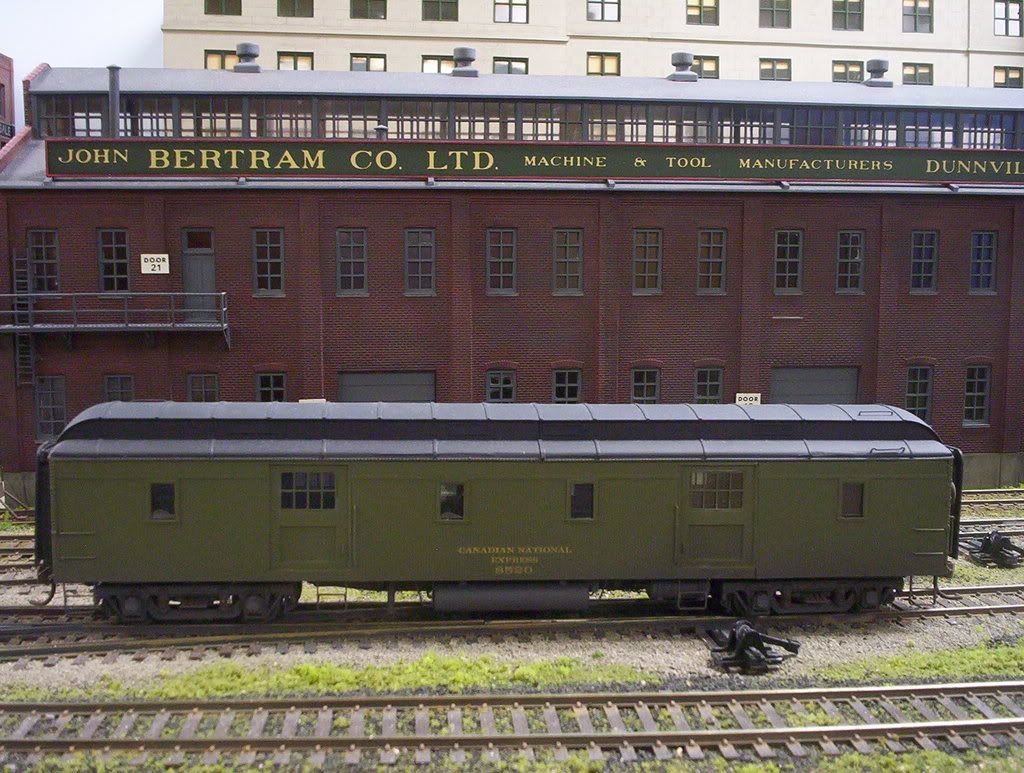

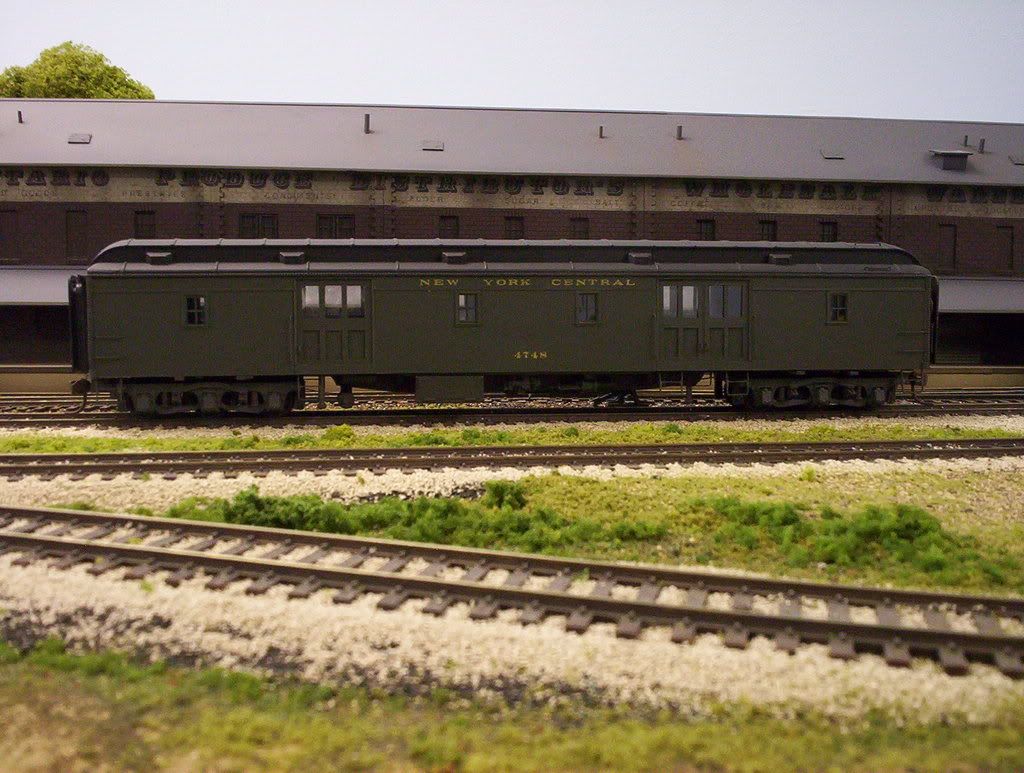
A shortened Athearn observation car:
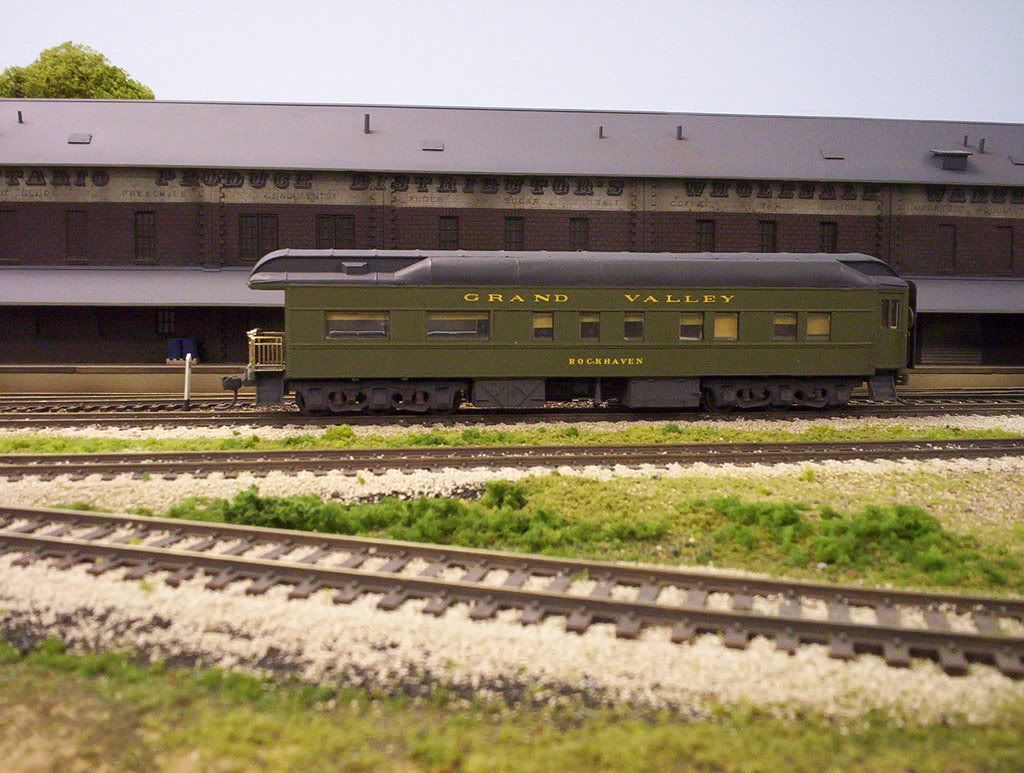
And a modified Athearn baggage car:
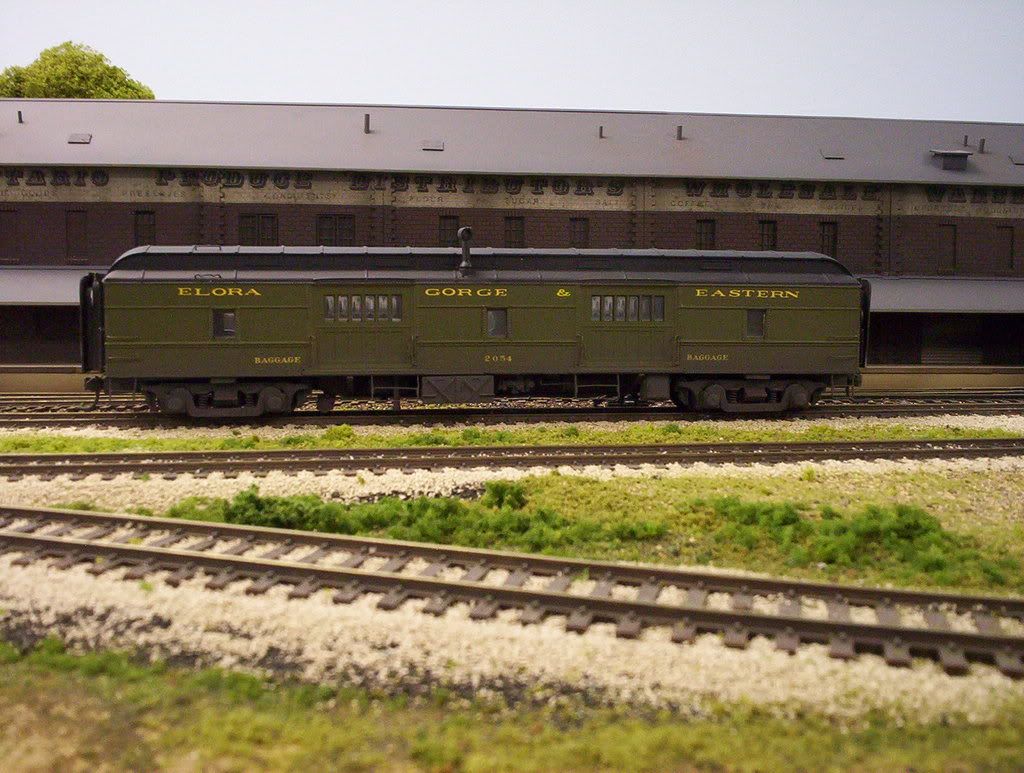
Wayne
Very nice work Wayne.
Sheldon